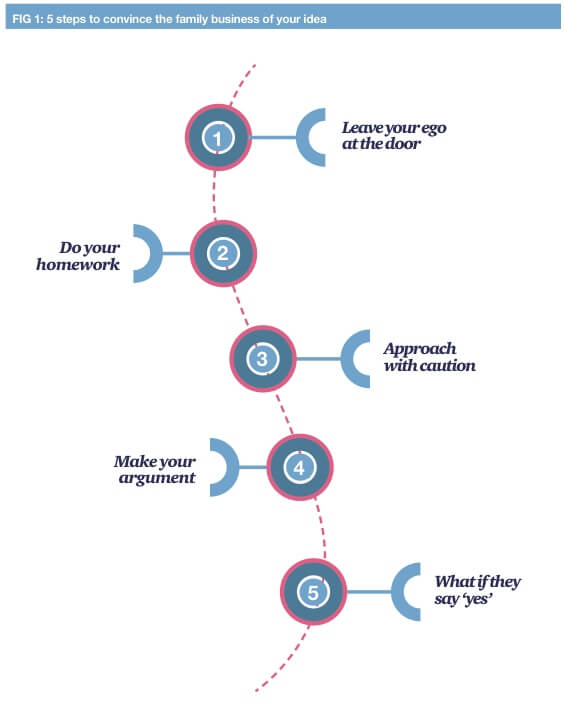Encountering resistance to change has often caused the young members of a family to feel reluctant to join the family business. For the same reason some prefer to leave after only a few years of working with the family. Though raised in a fast-paced technological world and thus known as the early adopters of digital innovation, members of Generation Y are not always successful in effectuating change in their family firms. In the following article by Langdon Evans, Relationship Manager at TrustedFamily and member of a multigenerational family business, he explains why Gen Y members often fail at making a difference in the family business and how they can convince, not confuse.
Case in point
I was recently talking with a next generation member of a 3rd generation family business about the challenges incumbent upon bringing new ideas into a family business. At 23 years old, David (not his real name) had been involved in his family business for a few years and had noticed that his families approach to communicating with each other was in his words, “from the dark ages.”
David decided that he was going to help his family make a much needed change. Unfortunately, his first attempt at proposing modern communication tools involved simply printing off a few pages of information and approaching his uncle, the chairman of the board. Not surprisingly, David was shut down fairly quickly. He told me that he felt like the rest of the family was not giving him the time of day or the credit he deserved. “They only see me as someone young,” he said. “But I know my ideas would help change our family business for the better.”
[ms-protect-content id=”4069, 4129″]
I had the good fortune to later talk with David’s uncle, and asked him why he had shut down David’s initial attempt at such a project. “I really didn’t understand what he wanted,” Tim said. “All I heard from him [David] was that we were doing things the wrong way.”
This is a common occurrence in family businesses and can unfortunately lead to many negative interactions as well as the loss of potentially progressive solutions. Family businesses can be both the safest and most trying environments for young members. On one hand, the family environment is often full of educational opportunities. Young family members are able to learn invaluable skills that their peers working in non-family corporations might not have access to. On the other hand, ambition to work in and for the family business can dissolve into deep frustration for younger members who feel they are unable to enact changes or propose new ideas.
In David’s case, there was a generational divide between an elder family member and a Gen Y member. David felt that Tim did not understand the importance of improving family communication through technology. Tim was unable to receive David’s input as anything other than a complaint about a company he was labouring to sustain.
How to make a change
The biggest roadblock for young members when trying to carry out new ideas in the business is how to communicate why there is a need and which options the family can utilise to address it. When a solution is completely understood, general consensus can be achieved across all generations of the family. Members of Generation Y have been born in a time when technological advances have become the norm and early adoption is a matter of fact. The urgency of understanding how new ideas and change can be introduced into the family business is the natural progression of such adaptations. This ease of adaptation can also be seen as impatience with current systems, so Gen Y members will be well served in adhering to the following five steps when proposing new ideas and possibly facing push back whilst attempting to convince their families of necessary change:
1. Leave your ego at the door
If you are a member of Generation Y, you might be a few steps ahead of many family business members in terms of modern technology and your family will very likely take notice of this. In order to make a real contribution and have an effective impact on the business, it is imperative that you check your ego at the door. Other family members will not take kindly to your asking for your ego to be stroked when you are pitching a new idea. Remember that you are doing this to improve the health of the family business, not for personal triumph.
2. Do your homework
Before you can introduce changes or improvements, you have to understand how family businesses work and communicate. You cannot convince anyone of adopting changes if you do not know the environment you are proposing to execute the changes in. Knowing whom you are dealing with and what areas of the family business will be most affected by a new technology or thought process will help you make your case once you are called upon to present the idea to the other family members.
3. Approach with caution
Once you have left your ego at the door and have done your homework on how the family business works, you have to approach the family with your idea. Your first task is to be prepared and knowledgeable about your proposal. Arriving at a board meeting and merely stating that you think it is a good idea to implement drastic change has a diminished rate of success. You have to know the ins and outs of what you are proposing. Be ready to give a presentation, deliver facts and answer questions. The more you know and can demonstrate your interest, the more seriously you will be taken. Do you have examples of the successful application of the idea you are proposing? What will it take to employ your idea? Having a timeline and various points of action will make all the difference in presenting a project.
It is also imperative at this point to build consensus among the key influencers in the family regarding your solution. Consider having a one-on-one meeting with a particular board member or asking certain influencers to review your current information and presentation. Bringing individuals over to your side and updating them on your project does not need to happen in one big presentation and will help you build confidence when presenting your argument.
4. Make your argument
While you are standing in that boardroom or in front of a management committee and are defending your new ideas, attempt to understand the different generations active in your family business. Consider their experience and life outside the family. For instance, if you are in a third generation family business, it is likely that the founding generation is known for its entrepreneurship and drive, but in the greater context they belong to a generation known either as the Traditionalists or Baby Boomers. Keep in mind that Traditionalists are known to respect authority and hard work, and Baby Boomers see work ethic as the pillars of which accomplishments are built upon (WMFC, 2013). In order to bring about a collective change in mind set within each generation you must appeal to these characteristics by both honouring their seniority and making clear that you are willing to put in the work necessary.
5. What if they say ‘yes’
Once you get approval on your new idea, the work then truly begins. You must become the go-to person for all concerns related to realising what you have proposed. Surround yourself with the right people for working on your project and be respectful of the inevitable challenges, which may arise unforeseen. Reach out for help if you need it. There is a myriad of resources available for facing challenges in family businesses.
Whether it is particular to Generation Y or simply a fact of youth (which has proven endlessly that young people crave change), the next generation should always be allowed to not only preserve the legacy of the family business but also to propose fresh ideas that may or may not lead to improvement. How successfully Gen Y members participate will largely depend on their ability to communicate their goals clearly and to follow through on their respective visions.
Tharawat Magazine, Issue 23, 2014
[/ms-protect-content]














